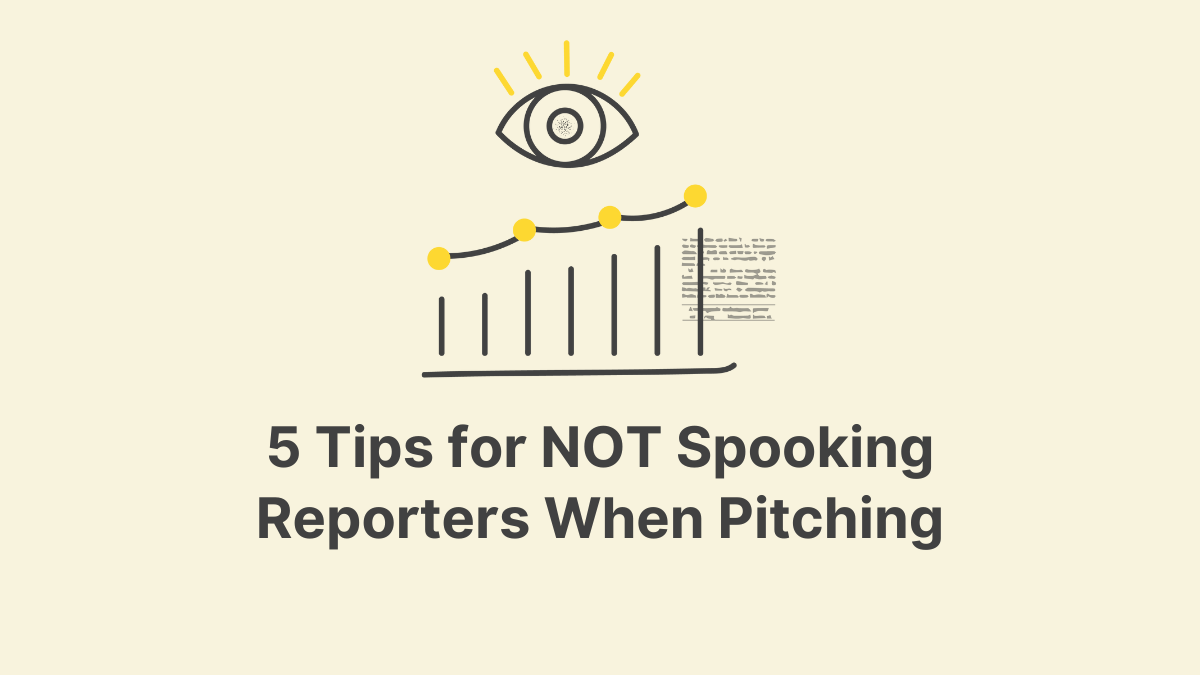5 Tips for NOT Spooking Reporters When Pitching

When pitching, even the most well-meaning PR reps can make mistakes that send chills down a journalist’s spine. With inboxes full of messages vying for attention, reporters quickly notice when something feels “off” about a pitch. If you’ve caught episodes of our Coffee with a Journalist podcast, certain pitching missteps are more frightening than others.
Whether it’s vague subject lines, unclear angles, or relentless follow-ups, there are specific ways to keep your pitch from turning into a horror show. By taking a thoughtful approach, you’re far more likely to get a positive response and build a long-term relationship with the journalist rather than scaring them off.
Here are five pitching tips from top journalists—like Anna Tingley (Variety), Melissa Daniels (Modern Retail), Leo Schwartz (Fortune), Conz Preti (Business Insider), and Rebecca Pifer (Healthcare Dive)—to make sure your pitch is more “treat” than “trick.”
1. Don’t Use Cryptic Subject Lines
A vague subject line can send shivers down a journalist’s spine, making them wary of what lurks within and be inclined to hit delete. With countless pitches flooding their inbox, journalists rely on clear subject lines to quickly assess the relevance and importance of your message. If they're confused, their instinct will be to protect themselves from potential time-wasting content.
What to Do Instead
Craft a clear, engaging subject line that captures attention from the get-go. Journalists like Melissa Daniels suggest direct, relevant lines mentioning the brand or topic, helping your pitch stand out in the most crowded inboxes and signaling that it’s worth reading.
2. Craft a Pitch, Not a Bewitching Riddle
For busy reporters, dense paragraphs in a pitch can feel as disorienting as deciphering a complicated spell. If they can’t quickly grasp the core of your message, they're likely to abandon your pitch and move on to the next one.
What to Do Instead
Organize your pitch with bullet points for structure and clarity. Anna Tingley and Melissa Daniels both favor concise and easy-to-scan pitches free from cluttered blocks of text. Your goal is to make the story’s core as straightforward as possible.
3. Don’t Send Pitches From Beyond the Reporter’s Beat
Pitches that stray beyond a journalist’s beat are like eerie shadows lurking in a graveyard—confusing, unwelcome, and sure to send them running for cover. This disconnect not only risks losing their interest but also jeopardizes your reputation. Journalists might begin to see you as someone who doesn’t respect their time or expertise, making them hesitant to engage with your future outreach.
What to Do Instead
Do your homework to ensure the pitch aligns with their beat and is timely. Rebecca Pifer and Leo Schwartz stress the importance of relevance and tailor your pitch to the journalist's beat. Understanding their specific areas of interest can go a long way in making your pitch stand out. Otherwise, your email risks being lost forever in the eerie depths of the trash or junk folder.
4. Don't Haunt Reporters
Appearing in multiple inboxes and DMs can leave reporters feeling like they’re being haunted. If they’re overwhelmed by a barrage of messages, they might not know where to respond—or they may walk away with a less-than-favorable impression.
What to Do Instead
Email is the preferred method for sending pitches, with Anna Tingley, Melissa Daniels, Leo Schwartz, and Rebecca Pifer all agreeing that it helps prevent pitches from getting lost in the shadows. Since most reporters have their own strategies for managing their inboxes, sending a pitch via social media means there's no guarantee it will be seen.
5. Stay Authentic to Avoid Getting Ghosted
Journalists can sense when a pitch lacks sincerity or substance, and it’s a surefire way to end up ignored. Remember, authenticity is key, and a lack of it can come back to haunt you.
What to Do Instead
Make sure you’ve conducted thorough research and are presenting a pitch that is both relevant and meaningful. For example, Conz Preti values pitches that resonate with her focus, and Leo Schwartz is drawn to those backed by credible sources. Sending pitches that don’t match a journalist’s beat is like leading them into a dead-end—a frustrating waste of time.
By following these tips, you’ll keep your pitches from scaring off journalists and instead offer a pleasant “treat.” Avoid vague subject lines, favor email, make things easy to read, and stay relevant, and you’re much more likely to get a response that’s warm rather than chilling.
For more journalist-approved insights, listen to #CoffeeWithAJournalist… if you dare!
______
Want More Blogs Like This?
Fill out the form below to subscribe to our newsletter and receive emails with the top blogs from The TypeBar!
